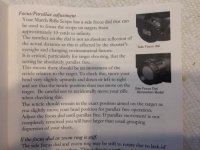B
Brian Adams
Guest
Do you leave it or hope the gun tracks in the same spot each time. I adjust to my eyes!
The objective needs to be adjusted for zero parallax error after every target distance change. The ocular (eyepiece) must of course be adjusted for your eye to obtain a clear image of the reticle and target without unnecessary eye strain, but a wide range of settings will not be a big distraction for most people for casual shooting, but for serious, extended benchrest sessions where extreme accuracy counts, you would want to adjust it for the shooter's eye.


